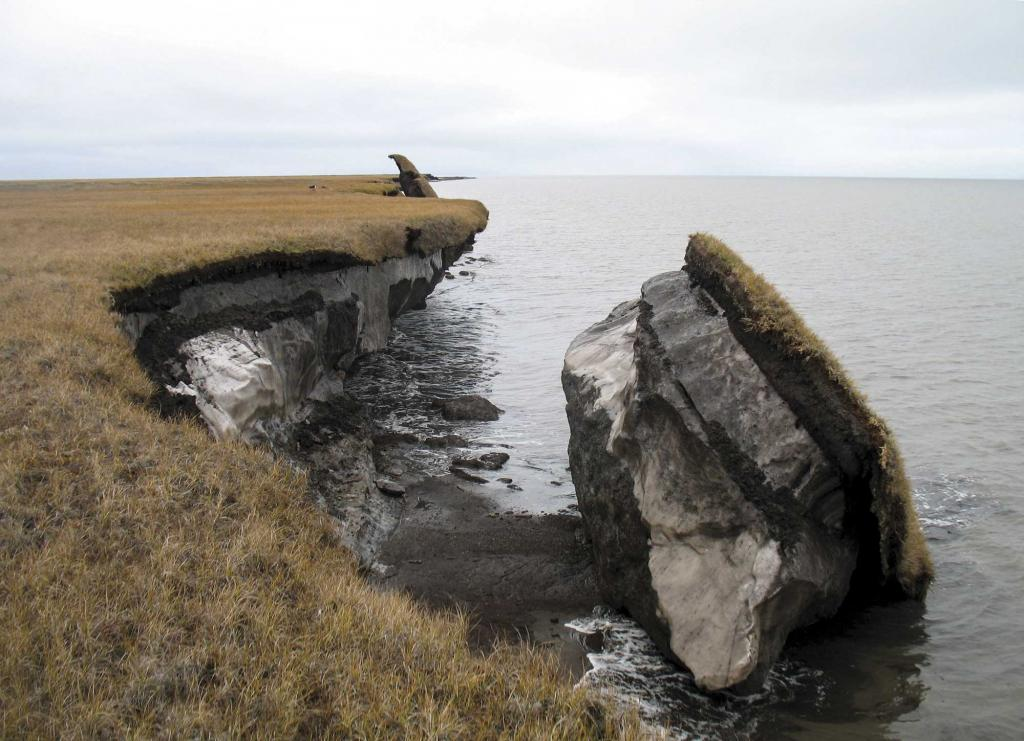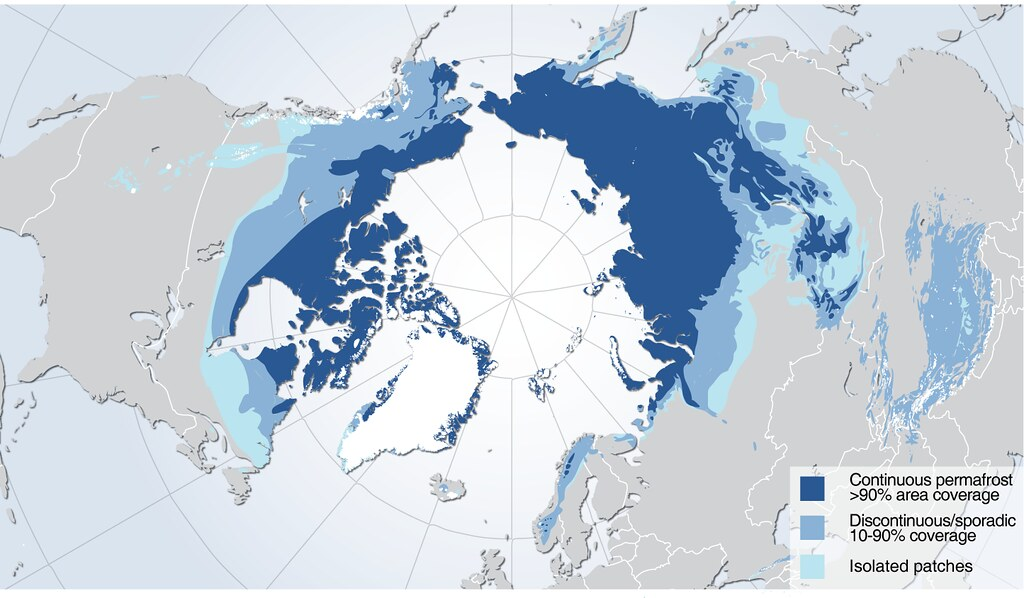Description

Copyright infringement not intended
Picture Courtesy: https://www.downtoearth.org.in/news/climate-change/northern-permafrost-region-on-track-to-become-carbon-source-instead-of-sink-due-to-global-warming-95735
Context: According to the new study, the northern permafrost region, covering a quarter of the northern hemisphere, is now emitting more greenhouse gases (GHGs) into the atmosphere than it is capturing.
Details
- A new study published in the journal Global Biogeochemical Cycles has found that the northern permafrost region is now emitting more greenhouse gases (GHGs) into the atmosphere than it is capturing or absorbing. This region, covering about a quarter of the northern hemisphere, is projected to shift from being a net carbon sink to a net carbon source due to global warming.
Key Highlights of the study
- The northern permafrost region, which historically acted as a significant carbon and nitrogen sink, is now transitioning to become a net source of greenhouse gases (GHGs) due to global warming. This shift is primarily driven by increasing temperatures that result in melting permafrost, exposing substantial quantities of organic carbon and resulting in the release of carbon dioxide (CO2), methane (CH4), and nitrous oxide (N2O) into the atmosphere.

Magnitude of GHG Emissions (2000-2020)
- The study estimates substantial emissions of GHGs from the northern permafrost region between 2000 and 2020.
- Methane (CH4) is a potent greenhouse gas with a much higher global warming potential than carbon dioxide over shorter time frames. The emission of 38 million tonnes of methane from the northern permafrost region underscores the substantial impact of permafrost thaw on methane release.
- Nitrous Oxide (N2O) is another powerful greenhouse gas, albeit less prevalent in the atmosphere compared to carbon dioxide and methane. The emission of 670,000 tonnes of nitrous oxide highlights the contribution of permafrost thaw to the overall GHG budget.
- Carbon Dioxide (CO2) is the most abundant greenhouse gas emitted from human activities and natural processes. Although permafrost-related carbon dioxide emissions (12 million tonnes) are lower compared to methane, CO2 remains a significant contributor to the atmospheric GHG concentration.
Implications of GHG Emissions
- Global Climate Impact: The substantial emissions of methane, nitrous oxide, and carbon dioxide from permafrost thaw contribute to the overall increase in greenhouse gas concentrations in the atmosphere. This can lead to enhanced global warming and climate change impacts.
- Permafrost Carbon Feedback: The release of GHGs, particularly methane and carbon dioxide, due to permafrost decline can trigger a positive feedback loop known as the 'permafrost carbon feedback'. As more GHGs are released, they contribute to further warming, which in turn accelerates permafrost thaw and additional GHG emissions.
- Regional and Global Consequences: The emissions from the northern permafrost region have implications not only for local ecosystems but also for global climate dynamics. Methane emissions, in particular, can have a more immediate impact on atmospheric warming due to its potency as a greenhouse gas.
Net GHG Fluxes Including Lateral Fluxes
- The permafrost region was estimated to be a net source of 144 million tonnes of carbon dioxide (CO2) and methane (CH4) when considering lateral fluxes such as erosion. This indicates that more GHGs (in the form of CO2 and CH4) were released into the atmosphere than were being captured or sequestered by the region's ecosystems.
Implications of Net GHG Fluxes
- Climate Forcing: The substantial net emissions of carbon dioxide and methane from the permafrost region contribute to the overall climate forcing, leading to increased global warming and associated climate impacts.
- Erosion and Landscape Changes: Lateral fluxes, including erosion, play a critical role in redistributing carbon and nitrogen within the permafrost landscape. Erosion can expose organic carbon stored in soils and accelerate the release of GHGs into the atmosphere.
- Carbon Feedback: The net emissions of CO2 and CH4 from the permafrost region contribute to the positive feedback loop known as the 'permafrost carbon feedback'. As more GHGs are released due to permafrost thaw and erosion, the warming effect intensifies, further exacerbating permafrost thaw and GHG emissions.

Role of Terrestrial Ecosystems in CO2 Dynamic
- The study confirms that terrestrial ecosystems in the permafrost region act as carbon dioxide (CO2) sinks, meaning they absorb more CO2 from the atmosphere than they release.
- Carbon Sequestration: Terrestrial ecosystems, such as forests and vegetation, play a crucial role in sequestering carbon through photosynthesis. Plants absorb CO2 during photosynthesis and store carbon in biomass and soils.
Factors Offsetting CO2 Sink Effect
- Emissions from Fires: One significant factor that offsets the CO2 sink effect of terrestrial ecosystems is emissions from fires. Wildfires release stored carbon back into the atmosphere as CO2, especially when vegetation burns.
- Inland Waters: Inland waters, including lakes, rivers, and streams within the permafrost region, can also release CO2 through natural processes like the decomposition of organic matter. This contributes to carbon emissions from terrestrial ecosystems.
Implications of Offsetting CO2 Sink
- Carbon Balance: The offsetting effect of emissions from fires and inland waters challenges the overall carbon balance of terrestrial ecosystems. While these ecosystems sequester carbon under normal conditions, disturbances like wildfires can lead to significant carbon losses.
- Climate Feedback: Increased emissions from fires and other disturbances can exacerbate climate feedback loops. Higher temperatures and drier conditions, driven by climate change, can promote more frequent and intense wildfires, further impacting the carbon dynamics of terrestrial ecosystems.
|
Policy and Management Considerations
●Fire Management: Implementing effective fire management strategies, such as wildfire prevention, early detection, and suppression, can help mitigate carbon emissions from fires and preserve the carbon sink capacity of forests and vegetation.
●Wetland Conservation: Protecting and conserving wetlands within the permafrost region is essential for minimising CO2 emissions from inland waters. Preserving natural habitats and reducing disturbances can help maintain the carbon balance of aquatic ecosystems.
●Climate Resilience: Building climate resilience in terrestrial ecosystems involves adaptive strategies that consider the impacts of climate change on carbon dynamics. Enhancing ecosystem resilience can contribute to sustainable carbon sequestration and climate mitigation efforts.
|
Contribution of Atmospheric CO2 and CH4
- Atmospheric CO2 contributed 8% to the total carbon released from the permafrost region between 2000 and 2020.
- While CO2 emissions from the permafrost region represent a smaller proportion compared to other greenhouse gases, atmospheric CO2 is a key component of the global carbon cycle. The release of CO2 from thawing permafrost contributes to atmospheric CO2 concentrations, influencing climate change.
Contribution of Atmospheric CH4
- Percentage of Total GHG Emissions: Atmospheric CH4 contributed 26.5% to the total greenhouse gas (GHG) emissions from the permafrost region during the study period.
- Significant Role of Methane: The substantial contribution of methane highlights its importance in the overall GHG budget of the permafrost region. Methane is a potent greenhouse gas with a much higher warming potential compared to CO2 over shorter time frames.
Implications of CO2 and CH4 Contributions:
- Climate Forcing: The combined contributions of atmospheric CO2 and CH4 from the permafrost region contribute to climate forcing, leading to enhanced greenhouse effect and global warming.
- Feedback Mechanisms: Increased emissions of CO2 and CH4 from thawing permafrost can trigger positive feedback loops, further accelerating climate change. This phenomenon, known as the 'permafrost carbon feedback', amplifies the impact of global warming.
|
Policy and Mitigation Strategies
●Reducing Methane Emissions: Implementing measures to reduce methane emissions, such as methane capture and utilisation, can help mitigate the impact of thawing permafrost on atmospheric methane concentrations.
●Addressing CO2 Emissions: Promoting land management practices that enhance carbon sequestration and reduce CO2 emissions, such as reforestation and sustainable land use, can contribute to mitigating climate change.
●Climate Policy: Integrating permafrost carbon dynamics into climate policy frameworks is essential for addressing the unique challenges posed by thawing permafrost and its impact on global carbon budgets.
|
Conclusion
- The research highlights the urgent need to address thawing permafrost and its impact on global carbon emissions. It highlights the complex interactions within the permafrost ecosystem and calls for comprehensive monitoring and research efforts to mitigate the potential acceleration of climate warming due to permafrost carbon feedback.
Source:
Down to Earth
|
PRACTICE QUESTION
Q. Scientists are concerned about a positive feedback loop related to melting ice and climate change. What does this feedback loop involve?
A) Increased cloud cover reflects more solar radiation, slowing down warming.
B) Rising temperatures cause more ice to melt, reducing Earth's albedo and accelerating warming.
C) Ocean currents weaken due to freshwater influx from melting ice, disrupting global heat distribution.
D) Volcanic eruptions release aerosols that reflect sunlight, mitigating the effects of warming.
Answer: B
|












